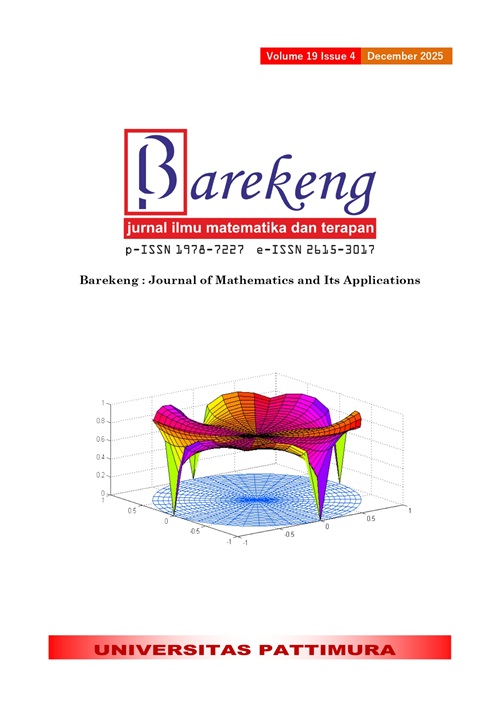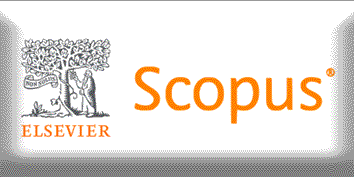THE TRIPLE IDENTITY GRAPH OF THE RING Z_n
Abstract
Let be a commutative ring with identity and is an identity element of . The triple identity graph of the ring , represented by ), is an undirected simple graph with the vertex set . In , two different vertices and is called adjacent if there is an element such that and . The triple identity graph of the ring of integers modulo , represented by , is the subject of this study. We obtain several results regarding the properties of the graph , which are summarized as follows. The graph is a connected graph if and only if is prime and . If is connected, then diam and gr. Furthermore, is a Hamiltonian graph if is a prime number and .
Downloads
References
I. Beck, “COLORING OF COMMUTATIVE RINGS,” J. Algebr., vol. 116, no. 1, pp. 208–226, 1988, doi: https://doi.org/10.1016/0021-8693(88)90202-5.
D. F. Anderson and P. S. Livingston, “THE ZERO-DIVISOR GRAPH OF A COMMUTATIVE RING,” J. Algebr., vol. 217, no. 2, pp. 434–447, 1999, doi: https://doi.org/10.1006/jabr.1998.7840.
D. Sinha and B. Kaur, “ON BECK’S ZERO-DIVISOR GRAPH,” Notes Number Theory Discret. Math., vol. 25, no. 4, pp. 150–157, 2019, doi: https://doi.org/10.7546/nntdm.2019.25.4.150-157.
R. Akhtar and L. Lee, “CONNECTIVITY OF THE ZERO-DIVISOR GRAPH FOR FINITE RINGS,” Involv. (Journal Math. ), vol. 9, no. 3, pp. 415–422, 2016.doi: https://doi.org/10.2140/involve.2016.9.415
M. Bakhtyiari, R. Nikandish, and M. J. Nikmehr, “COLORING OF COZERO-DIVISOR GRAPHS OF COMMUTATIVE VON NEUMANN REGULAR RINGS,” Proc. Indian Acad. Sci. Math. Sci., vol. 130, no. 1, pp. 1–9, 2020, doi: https://doi.org/10.1007/s12044-020-00569-5.
A. M. Dhorajia, “SOME GRAPH ON PRIME IDEALS OF A COMMUTATIVE RING,” Int. Electron. J. Algebr., vol. 23, pp. 157–166, 2018, doi: https://doi.org/10.24330/ieja.373659.
A. M. Alanazi, M. Nazim, and N. Ur Rehman, “PLANAR, OUTERPLANAR, AND TOROIDAL GRAPHS OF THE GENERALIZED ZERO-DIVISOR GRAPH OF COMMUTATIVE RINGS,” J. Math., vol. 2021, 2021, doi: https://doi.org/10.1155/2021/4828579.
B. S. Reddy, R. S. Jain, and N. Laxmikanth, “VERTEX AND EDGE CONNECTIVITY OF THE ZERO DIVISOR GRAPH Γ(Zn),” pp. 1–7, 2018, [Online]. Available: http://arxiv.org/abs/1807.02703
P. Potoˇ, “GIRTH-REGULAR GRAPHS ∗,” vol. 3966, pp. 349–368, 2019.doi: https://doi.org/10.26493/1855-3974.1684.b0d
C. Balbuena, P. Garca-Vzquez, and L. P. Montejano, “SUPERCONNECTIVITY OF GRAPHS WITH ODD GIRTH G AND EVEN GIRTH H,” Discret. Appl. Math., vol. 159, no. 2–3, pp. 91–99, 2011, doi: https://doi.org/10.1016/j.dam.2010.10.003.
K. Samei, “ON THE COMAXIMAL GRAPH OF A RING,” AKCE Int. J. Graphs Comb., vol. 57, no. 2, pp. 413–423, 2014, doi: https://doi.org/10.4153/CMB-2013-033-7.
M. Miller, “MOORE GRAPHS AND BEYOND: A SURVEY OF THE DEGREE/DIAMETER PROBLEM,” Electron. J. Comb., vol. 1, no. DynamicSurveys, 2018.
H. Wang, J.-B. Liu, S. Wang, W. Gao, and S. Akhter, “SHARP BOUNDS FOR THE GENERAL SUM‐CONNECTIVITY INDICES OF TRANSFORMATION GRAPHS,” 2017, Hindawi. doi: https://doi.org/10.1155/2017/2941615.
G. Aalipour and S. Akbari, “ON THE CAYLEY GRAPH OF A COMMUTATIVE RING WITH RESPECT TO ITS ZERO-DIVISORS,” Commun. Algebr., vol. 44, no. 4, pp. 1443–1459, 2016, doi: https://doi.org/10.1080/00927872.2015.1027359.
A. Sharma and D. K. Basnet, “NIL CLEAN DIVISOR GRAPH,” pp. 1–9, 2019, [Online]. Available: http://arxiv.org/abs/1903.02287
K. Toker, “Zero-Divisor Graphs Of Catalan Monoid,” Hacettepe J. Math. Stat., vol. 50, no. 2, pp. 387–396, 2021, doi: https://doi.org/10.15672/hujms.702478.
E. Y. Çelikel, “THE TRIPLE ZERO GRAPH OF A COMMUTATIVE RING,” Commun. Fac. Sci. Univ. Ankara Ser. A1 Math. Stat., vol. 70, no. 2, pp. 653–663, 2021, doi: https://doi.org/10.31801/cfsuasmas.786804.
T. Hartati and V. Y. Kurniawan, “CONSTRUCT THE TRIPLE NILPOTENT GRAPH OF RING USING PYTHON,” AIP Conf. Proc., vol. 2886, no. 1, 2023, doi: https://doi.org/10.1063/5.0154928.
I. N. Fitriani and V. Y. Kurniawan, “ALGORITHM FOR CONSTRUCTING THE TRIPLE UNIT GRAPH OF TYPE II OF RING Z_n USING PYTHON,” BAREKENG J. Ilmu Mat. dan Terap., vol. 18, no. 3, pp. 1639–1648, 2024, doi: https://doi.org/10.30598/barekengvol18iss3pp1639-1648.
S. Akbari, M. Habibi, A. Majidinya, and R. Manaviyat, “ON THE IDEMPOTENT GRAPH OF A RING,” J. Algebr. its Appl., vol. 12, no. 6, 2013, doi: https://doi.org/10.1142/S0219498813500035.
E. S. Cahyati, R. M. I. Maharani, S. Nurhayati, and Y. Susanti, “GENERALIZED NON-BRAID GRAPHS OF RINGS,” J. Fundam. Math. Appl., vol. 5, no. 2, pp. 192–201, 2022, doi: https://doi.org/10.14710/jfma.v5i2.14152
A. Patil and P. S. Momale, “IDEMPOTENT GRAPHS, WEAK PERFECTNESS, AND ZERO-DIVISOR GRAPHS,” Soft Comput., vol. 25, no. 15, pp. 10083–10088, 2021, doi: https://doi.org/10.1007/s00500-021-05982-0.
S. Razaghi and S. Sahebi, “A GRAPH WITH RESPECT TO IDEMPOTENTS OF A RING,” J. Algebr. its Appl., vol. 20, no. 6, 2021, doi: https://doi.org/10.1142/S021949882150105X.
V. Y. Kurniawan, B. Purboutomo, and N. A. Kurdhi, “CONNECTIVITY OF THE TRIPLE IDEMPOTENT GRAPH OF RING Zn,” Int. J. Comput. Sci. Appl. Math., vol. 10, no. 1, pp. 34–37, 2024, doi: https://doi.org/10.12962/j24775401.v10i1.20266.
V. Y. Kurniawan and C. F. Ekasiwi, “ALGORITHM FOR CONSTRUCTING TRIPLE IDENTITY GRAPH OF RING Z_n USING PYTHON,” BAREKENG J. Ilmu Mat. dan Terap., vol. 18, no. 3, pp. 1629–1638, 2024, doi: https://doi.org/10.30598/barekengvol18iss3pp1629-1638.
G. Chartrand, L. Lesniak, and P. Zhang, GRAPHS & DIGRAPHS, 6th ed. New York: CRC Pers Taylor and Francis Group, 2016. doi: https://doi.org/10.1201/b19731.
Copyright (c) 2025 Vika Yugi Kurniawan, Chessa Fanny Ekasiwi; Santoso Budi Wiyono

This work is licensed under a Creative Commons Attribution-ShareAlike 4.0 International License.
Authors who publish with this Journal agree to the following terms:
- Author retain copyright and grant the journal right of first publication with the work simultaneously licensed under a creative commons attribution license that allow others to share the work within an acknowledgement of the work’s authorship and initial publication of this journal.
- Authors are able to enter into separate, additional contractual arrangement for the non-exclusive distribution of the journal’s published version of the work (e.g. acknowledgement of its initial publication in this journal).
- Authors are permitted and encouraged to post their work online (e.g. in institutional repositories or on their websites) prior to and during the submission process, as it can lead to productive exchanges, as well as earlier and greater citation of published works.






1.gif)



